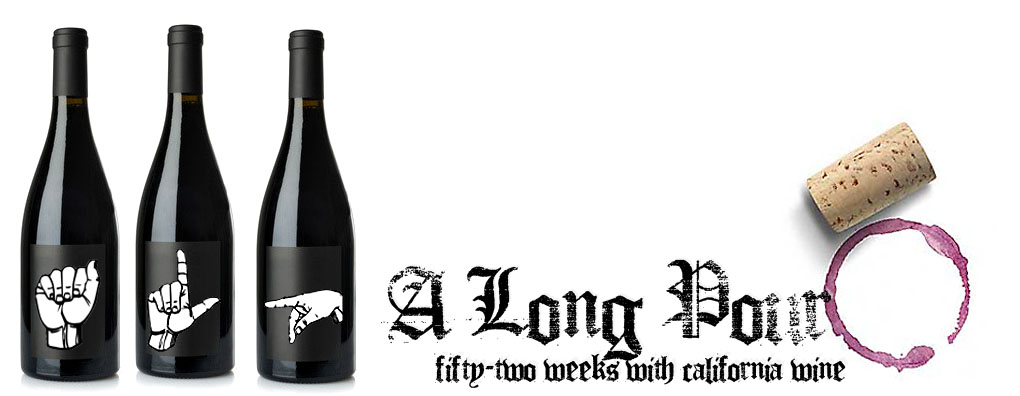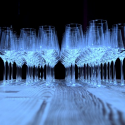In Thanks to Ground Effect Wine
There are a few moments in our travels over the last 27 months that have changed everything for us, our perspective, our vision, our goals.
Jason Haas at Tablas Creek, Adam Tolmach of The Ojai Vineyard, my initial visit to Jordan Winery, Matthias Pippig, Randall Grahm, Matt Trevisan. Sometimes it was the people, sometimes the vineyards, but all of them changed our way of thinking in one way or another and we are thankful for it.
There is one other name on that list that I might possibly put at the very top. He, through the thoughtfulness of his words, the clarity of his vision, and the character of his heart, has shown us, has shown me a new way, the way I wish all people could see wine. Beyond the big picture, beyond a product, there is the infinite immenseness that is all the small things, of the earth, of the soil, of the plants and bugs, of the terroir. It is these things he has encouraged me to see, to try to find.
His name is Nick de Luca, and he is Ground Effect Wine.
In honor (and with much pride) of Jon Bonné’s piece A Winemaker to Watch goes his own way, I am republishing some of my 2010 interview with Nick. Much of what is said below changed everything for me.
—
Excerpt from “The Knight of Happy Canyon” – 2010
We spent some time bouncing around in his pick-up truck touring the vineyard. What might look to some as poor weed management, to Nick is a thing of beauty.
“The hands-off approach to the vineyard is an out-growth of our hands off approach to winemaking”, Nick explained. “My basic theory is; terroir is an unplanted field and then everything you do to it from that point forward obscures the terroir. Farming is an unnatural act, anything you do in the vineyard. So the whole idea is to reduce as many of those factors as possible, you take it down to only the things that make the wine taste better.”
One of the fun aspects of spending time with Nick is the fact that he is just as likely to quote a legendary winemaker as he is to reference an obscure Japanese farmer. “There was a Japanese farmer by the name of Masanobu Fukuoka, he wrote a book called One Straw Revolution and invented this style of farming he called ‘do nothing farming.’ Essentially he could farm about a hectare and a half and support his whole family and only work about 2 hrs a day and get yields bigger than his neighbors who were doing it in a scientific fashion. I read that and that was a huge eye opener for me and that’s how I came up with the whole concept that every time you intervene [in the vineyard] you take the terroir further away from nature.”
We spoke about their efforts to promote sustainable practices at the three vineyards sites. “It’s the right thing to do,’ he said, “anything less is a cop out.”
After a thorough tour of the vineyards we sat down with a few bottles and my trusty iPod to document what transpired.
Nick on some of his less conventional farming practices:
“Every lesson you learn in one vineyard with one variety you can apply to another. The vineyard that we farm in Santa Maria is a real challenge because of the climate and fighting mold and mildew…I don’t like using harsh chemical products. I’ve been studying all of this organic gardening literature actually. I started using this concoction that I found in a gardening text from the turn of the century that was baking soda, olive oil, and soap. And we started spraying that for mildew and it works. And the other one that worked that I found…was 1% milk solution.
In the process of trying to figure out one problem that a certain vineyard presents you, you get a whole bunch of different ideas that you can apply to the others.”
Has your time in Europe and New Zealand changed your approach to wine making?
“Yeah absolutely! New Zealand was really cool for me because, let’s be honest, it rains every day during harvest. In New Zealand you make wine. The stuff arrives in the winery and it looks like mush…and you make it into wine. That’s when I learned the whole idea of no half measures. If you are backed into a corner and you have to fix a problem, you just fix it…. I saw what it’s like to be incredibly interventionists.
Then Europe, the “aha” moment in Europe was when I was in Spain a couple of years ago. My wife and I went to Spain, we went there for the bullfights; it’s a minor passion of mine. I love bullfights. I’d been to Madrid, I’d been to Pamplona, I’d been to Barcelona for the Corrida, but I had never been to Seville. Everyone you talk to says ‘that’s the heart and soul of bull fighting’. So we went to Seville for the Corrida.
The next day we went to Sanlúcar for lunch. The next thing we know we are sitting next to this old guy Enrique Barbadillo. It turns out that Enrique Barbadillo owns the biggest sherry house in all the area, which is Manzanilla. So he said ‘you have to come visit me tomorrow and I will give you a tour’. All of the barrel halls (bodegas) are right in view of the sea there and the style is based on the foam rubber yeast growing on top of the wine in the barrel…We walk through this one bodega and he says to me, “in this one we can’t make Manzanilla, only Oloroso.’ What he meant was in this bodega the floor (the foam yeast) does not naturally grow on the wine in barrel. And I asked him ‘why not?’, and he said, ‘oh the church is in the way’.
What he was basically saying was, this church here blocked the ocean air from coming into his winery (to grow the yeast). So not only is your vineyard part of your terroir, but so is your winery, and so are your people. And for him to say so nonchalantly, “oh the church is in the way,” his father knew that, his grandfather knew that, that just opened my mind to everything.”
Do you have a favorite aspect of wine making?
“Well the vineyard part would be easy to say, I love vineyards and the research side of learning about vineyards now that I am into all of the arcane gardening textbooks. You know what it is; it’s really just the psychology. I love selling people grapes because I love walking the vineyard with them and trying to understand what they’re seeing. I see the world this way, and that grass is green, but what does green look like to you? Are you seeing something I would call blue? It was Don Blackburn who said, ‘wine business is people business.’ When you start to consider people are a part of your terroir, it changes everything.
So I would say it’s the people, it’s the psychology.”
—
I have no doubt that the coming months and years will see Nick and Ground Effect rise to become one of the most respected small brands in California. It is a joy to see such a generally nice person and family get this much deserved recognition.
For more, here is a link to Jon Bonné’s piece in the SF Gate as well as a short excerpt. You can also learn more about Ground Effect and order wine on thier site www.groundeffectwine.com
“A Winemaker to Watch goes his own way” – Jon Bonné
It’s heartening to see a Winemakers to Watch launch their own label because you can see the wines they truly want to make.
That’s what Nick de Luca has done. When Amanda Gold profiled him in 2008, he was the winemaker for the Star Lane and Dierberg labels in Santa Barbara County, having traded a law career in New York for an apprenticeship path that took him through Cline, Williams Selyem and beyond.
But by the 2009 harvest, he found he was making too many “humongous” wines that weren’t to his taste. It was underscored by an experiment in which he picked grapes at five different ripeness levels; in tasting, everyone preferred the wine made from fruit that had been marked “too underripe,” which made him reconsider the meaning of ripeness in Santa Barbara, especially in the Sta. Rita Hills.
When he got home at the end of the day, he typically craved a crisp Loire white or a cold beer. Why, he wondered, couldn’t he find wines from nearby to drink?
“My wife was finally the one who said, ‘Go make the wines you want,’ ” he recalled when I caught up with him in San Francisco last week.
That was the birth of Ground Effect, which he makes in San Miguel, north of Paso Robles. He left Dierberg in 2010. Currently he makes one white, Gravity Check, and one red, Rock Garden.”


